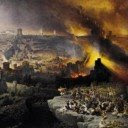Since the bulk of the previous post dealt directly with the more famous, larger beast with seven heads, we will take a short moment and discuss potential interpretation for the second, smaller beast. This beast is often referred to as the smaller beast , not because the description of it’s size leads to that assumption, but rather that he or it does his work at the bidding of the first beast. He is often called the False Prophet.
Rev. 13:11-15 Then I saw another beast rising out of the earth. It had two horns like a lamb and it spoke like a dragon. [12] It exercises all the authority of the first beast in its presence, and makes the earth and its inhabitants worship the first beast, whose mortal wound was healed. [13] It performs great signs, even making fire come down from heaven to earth in front of people, [14] and by the signs that it is allowed to work in the presence of the beast it deceives those who dwell on earth, telling them to make an image for the beast that was wounded by the sword and yet lived. [15] And it was allowed to give breath to the image of the beast, so that the image of the beast might even speak and might cause those who would not worship the image of the beast to be slain.
There is quite a bit of symbolic imagery at play here and some investigating is necessary to understand both the imagery and the usage of language.
The first thing to note is that this beast comes out of the land (earth) in contrast to the first beast that arose from the sea. This should lead the reader to see this second beast as being in relation to Israel in some way, since John continues to contrast the sea as Gentile nations and the land as Israel.
The second part of the description worth noting is that this beast has two horns like that of a lamb. This would suggest more of a religious connotation that a political or military one. But since it speaks like a dragon, which we saw previously describes Satan, this must represent a false or blasphemous religion.
There have been several options presented to try and understand just what this second beast represents, and we will discuss a few of them here.
FALSE PROPHETS
Commentators like David Chilton argue that this beast actually refers to the rampant number of False Christ and false Prophets during that time. This would make sense and correlate with Jesus’ own warnings in the Olivet Discourse. The Scripture of the New Testament period before the fall of Jerusalem constantly warned the church to be wary of these false teachers and prophets.
These were possibly Judiazers calling the new converts into the bondage of the Old Testament Covenant laws and rituals. This would be a false religious system and fit the description in relation to worshiping that which was false.
CONTINUING OLD TESTAMENT JUDAISM
This would make the second beast the religious leaders of the Jews in Israel. They would still be performing the ritual sacrifices, which after Christ would and should be seen as an abomination since the perfect Lamb had come and completed the work of salvation for His people.
To continue the Temple worship system would be a false religion. This coupled with the fact that the Gospels attest to the Jewish religious leader’s affiliation with Rome - “We have no king but Caesar.” The combined culpability of the Jewish leaders and Rome in the death of Christ and the persecution of the early Church cannot be denied.
ROMAN GOVERNOR
Many have argued this second beast was the Roman Procurator at the time, Gessius Florus. In this interpretation the two horns would be a symbolic representation of being lesser than the ten horned larger beast. The speaking like a lamb does not have religious overtones, but rather the image represents the “wolf in sheep’s clothing” style of deceitful rulership used.
This view would make sense within the context as the second beast had the authority to speak for the first beast and he demanded worship or allegiance to the first beast. He also could make the image become life like symbolically be doing the bidding of Rome and persecute the church under that authority.
EMPEROR CULT
The final popular interpretation is that the second beast represented the emperor worship cult under the terror filled reign of Nero. This was dealt with in more detail in a previous post on Nero. Simply put, Nero considered himself a god, and therefore demanded worship of his subjects. This demand for worship was under the penalty of death. This demand would be carried out by the local governors of each province, and hence, they would be acting as the second beast.
I have seen strong arguments from all sides here, but have lately gravitated toward the Jewish religious leaders and their joining forces with Rome to both kill Christ and persecute His Church. This will also make more sense as we are soon introduced to the Harlot who whores herself with Rome.





No comments:
Post a Comment